Karatsu, Saga
Karatsu (唐津市, Karatsu-shi) is a city located in Saga Prefecture on the island of Kyushu, Japan. Its name, formed from the Japanese word roots 唐 kara (China, or continental East Asia in general), and 津 tsu (port), signifies its historical importance as an ancient trading port between Japan with China and Korea.[1] The central area of Karatsu, which does not include the former cities and villages of Higashimatsuura District, has a population of 78,386.
Karatsu 唐津市 | |
|---|---|
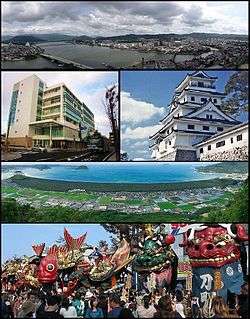 Top: View of Matsuura River and downtown Karatsu 2nd left: Oteguchi Bus Terminal, 2nd right:Karatsu Castle 3rd: Nijinomatsubara pine forest area Bottom: Karatsu Kunchi in November. | |
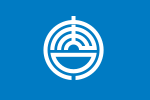 Flag  Emblem | |
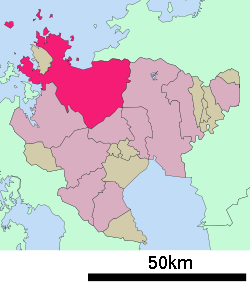 Location of Karatsu in Saga Prefecture | |
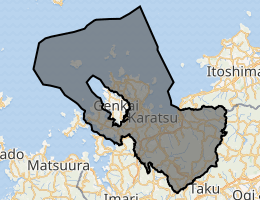
| |
 Karatsu Location in Japan | |
| Coordinates: 33°27′N 129°58′E | |
| Country | Japan |
| Region | Kyushu |
| Prefecture | Saga Prefecture |
| Government | |
| • Mayor | Toshiyuki Sakai |
| Area | |
| • Total | 487.59 km2 (188.26 sq mi) |
| Population (January 1, 2020) | |
| • Total | 117,663 |
| • Density | 240/km2 (630/sq mi) |
| Symbols | |
| • Tree | Pine |
| • Flower | Wisteria |
| Time zone | UTC+9 (JST) |
| City hall address | 1-1 Nishijōnai, Karatsu-shi, Saga-ken 847-8511 |
| Website | www |
| Karatsu | |||||
|---|---|---|---|---|---|
| Japanese name | |||||
| Kanji | 唐津市 | ||||
| Hiragana | からつし | ||||
| Katakana | カラツシ | ||||
| |||||
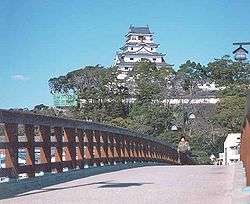
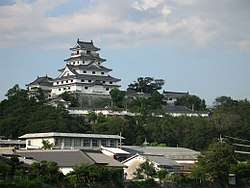
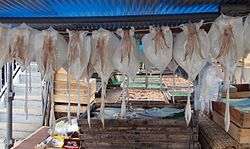
As of January 1, 2020, the city had an estimated population of 117,663 and a population density of 241 persons per km². The total area is 487.59 km².
On January 1, 2005, the towns of Chinzei, Hamatama, Hizen, Kyūragi, Ōchi and Yobuko. and the village of Kitahata (all from Higashimatsuura District) were merged into Karatsu.
On January 1, 2006, the village of Nanayama (from Higashimatsuura District) was merged into Karatsu.
Geography
Due to its proximity to mainland Asia, Karatsu has long been known as a stopover to Korea and China.
- Mountains: Mt. Sakurei (887.1 m), Mt. Hachiman (763.6 m), Mt. Tonbo (535 m)
- Natural Parks: Hachimandake Prefectural Natural Park, Sefuri-Kitayama Prefectural Natural Park, Tenzan Prefectural Natural Park
Adjoining municipalities
History
Under ritsuryō, the current city area was part of the Hizen Province. In 1591, on the coast of the northern part of the city (formerly the town of Chinzei), Nagoya Castle was constructed. The following year, it became the location from which the Imjin War was launched by Toyotomi Hideyoshi. In the middle of 1593, Terazawa Hirotaka created the Karatsu Domain and began governing it. In 1602, replacing Nagoya Castle, Karatsu Castle was constructed in what is now the heart of Karatsu. The tower of Karatsu Castle was built in 1966 .
- 1889-04-01 - The modern municipal system was established. The current city region is occupied by 1 town (Karatsu), and 19 villages (Hamasaki, Irino, Kagami, Karatsu, Kirigo, Kitahata, Kuri, Kyūragi, Minato, Mitsushima, Nagoya, Nanayama, Ōchi, Ōmura, Onizuka, Sashi, Uchiage and Yobuko).
- 1896-07-28 - Ōmura was renamed Tamashima.
- 1922-07-01 - Hamasaki was elevated to town status.
- 1922-11-01 - Nagoya changes the kanji of its name.
- 1924-01-01 - Mitsushima was incorporated into Karatsu Town.
- 1928-08-01 - Yobuko was elevated to town status.
- 1931-02-01 - Karatsu Village was incorporated into Karatsu Town.
- 1932-01-01 - Karatsu Town was elevated to city status.
- 1935-09-01 - Sashi and Ōchi both were elevated to town status.
- 1941-11-03 - Sashi was incorporated into Karatsu.
- 1952-05-03 - Kyūragi was elevated to town status.
- 1954-11-01 - Kagami, Kuri, Minato and Onizuka were all incorporated into Karatsu.
- 1956-09-30 - Hamasaki and Tamashima were merged to create the town of Hamasaki-Tamashima; and Nagoya and Uchiage were merge to create the town of Chinzei.
- 1958-11-01 - Kirigo was split and its parts were incorporated into Karatsu and Irino (respectively), and Irino was elevated to town status and was renamed Hizen.
- 1966-11-01 - Hamasaki-Tamashima was renamed Hamatama.
- 2005-01-01 - Karatsu merged with Chinzei, Hamatama, Hizen, Kitahata, Kyūragi, Ōchi and Yobuko to retain the name Karatsu.
- 2006-01-01 - Nanayama was incorporated into Karatsu.
Culture and tourism
The graceful Karatsu Castle stands watch over this castle town.
Karatsu is famous for its Karatsu Kunchi festival, which runs annually from November 2 to November 4 and is visited by approximately 500,000 visitors from all over Japan. The festival consists of 14 hikiyama (floats made of many layers of paper mache) being carried around the city's narrow streets to calls of "Enya!". Some hikiyama members say "Yoisa!". This accompaniment is one of the 100 Soundscapes of Japan. Regularly during Karatsu Kunchi, people in this town open their homes to friends and strangers to eat and drink; the primary focus is enjoying food, beer, and shochu, and having lively conversation.
In between Karatsu Station (唐津駅) and the main bus centre (大手口バスセンター) is a 170-metre arcade containing many small shops that specialize in Karatsu Kunchi omiyage, and the Korean-influenced local pottery which are called "Karatsu ware" since they refer to Japanese ceramic wares of Korean origin.[2] The actual date of production of the 'Karatsu Yaki' is believed to have begun being produced sometime "during the first half of the 16th century in the late Muromachi period."[3]
Museums in Karatsu include Kawamura Art Museum, Saga Prefectural Nagoya Castle Museum, and Matsurokan, and shrines, Kagami Jinja.
Yobuko
The former town of Yobuko merged with Karatsu on January 1, 2005.
Yobuko is famed for its fresh squid, Ika (烏賊) (いか) in Japanese, which is offered sashimi style, or it can be eaten while the squid is still alive. Yobuko also attracts local tourists, who come to see the Yobuko Big Bridge (呼子大橋).
Yobuko has a festival known as Yobuko Tsunahiki (呼子大綱引), or the Yobuko Tug of War, which takes place annually on the first Saturday and Sunday of June. The event involves a big tug-o-war between two factions in the town, the fishermen and farmers, and local legend says that if the hills faction wins, there will be a good harvest that year; and if the sea faction wins, there will be a good fishing harvest that year.
Beaches
Hamatama is one of the nicest beaches in Saga Prefecture. It is located close to central Karatsu and can be accessed by the JR Chikuhi Line.
Sister cities




Education
Prefectural senior high schools
- Karatsu Commercial High School
- Karatsu Higashi High School
- Karatsu Minami High School
- Karatsu Nishi High School
- Karatsu Seisho High School
- Karatsu Technical High School
- Kyūragi High School
Municipal junior high and elementary schools
- Junior high schools: 25
- Elementary schools: 44
National vocational schools
- Karatsu Maritime Polytechnical School
Schools for the handicapped
- Saga Prefectural Hokubu School for the Handicapped
Transportation
Air
The closest airports are Saga Airport and Fukuoka Airport.
Rail
- JR Kyūshū
- Karatsu Line
- Chikuhi Line (connected with the Fukuoka City Subway Kūkō Line)
- (from Fukuoka) Hamasaki Station - Nijinomatsubara Station - Higashi-Karatsu Station - Watada Station - Karatsu Station
- (to Imari) Honmutabe Station - Hizen-Kubo Station - Nishi-Ōchi Station - Sari Station
Road
- Expressways:
- National highways:
- Route 202
- Route 203
- Route 204
- Route 323
- Route 382
- Major Prefectural roads:
- Karatsu-Yobiko Route 23
- Imari-Hatagawachi-Kyūragi Route 32
- Karatsu-Hizen Route 33
- Kyūragi-Fuji Route 37
- Ōchi-Yamauchi Route 38
- Hamatama-Ōchi Route 40
- Hizen-Yobiko Route 47
- Karatsu-Kitahata Route 50
- Yamamoto-Hatatsu Route 52
References
- The New Encyclopædia Britannica, Micropædia, Vol:6,, 15th edition, 2003. p.740
- Britannica, Micropædia, 15th edition, p.740
- Britannica, Micropædia, 15th edition, p.740
External links
| Wikimedia Commons has media related to Karatsu, Saga. |
| Wikivoyage has a travel guide for Karatsu. |
- Karatsu City official website (in Japanese)
- Karatsu City official website (in English)
